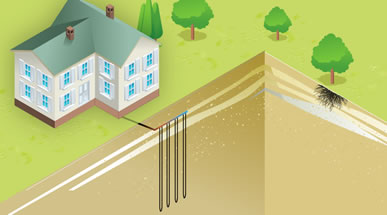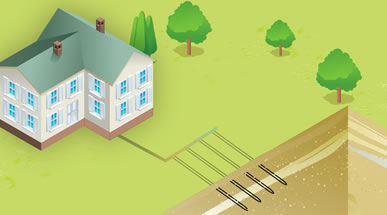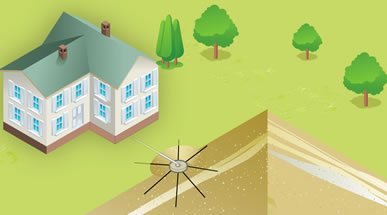


Geothermal Heat Pump Loop Fields
The Underground Portion
A geothermal heat pump system consists of two primary components, a heat pump and a loop field. The heat pump is the unit that is placed inside your home and is responsible for the heat exchange. The loop field is the system of piping that is laid underground in your yard and last for 50+ years! Loop fields vary based on the climate, the size of the home and location, but generally are responsible for about half of the total system installation cost. Loop fields can be installed horizontally or vertically, so what’s the difference? Its only in the way the pipe is inserted in the ground, no orientation is "better" then another as they all work effectively. Your ground loop orientation will depend on available space, ground conditions and your contractor's preference.

Vertical Loop Field
A vertical loop field is the most common installation process for a geothermal heat pump that is installed on smaller properties. During a vertical loop field installation a series of holes are drilled, each between 50-400 feet deep. Then, piping is fed down these holes and connected in a loop pattern. Once all of the pipes are connected together outside of the home they are threaded into your home and attached to the heat pump unit. This process is often completed by a well driller in 1-2 days.

Horizontal Loop Field
A horizontal loop field installation usually occurs in more rural areas or yards with lots of space. A horizontal loop field installation requires a great deal of land because a backhoe is used to dig up long trenches which are only a few feet deep (but below the frost line) in order to lay the necessary amount of piping. In some cases horizontal loop fields can be less costly to install than vertical because there is no drilling. Horizontal systems can be installed using an excavator or other ground moving machine and can be installed in 1-2 days.

Pond or Lake Loop Field
A pond loop field can be installed when the property is located near a large body of fresh water such as a pond or lake. Trenches, which measure only a few feet deep, are dug from the house to the body of water. These trenches are then filled with pipes which are connected to coils that are laid at the bottom of the lake or pond. These coils, often called slinkys, utilize the temperature at the base of the lake or pond to heat and cool the home just like a horizontal or vertical loop field. The image to the left is a slinky loop field.

DX Copper Loop Fields
Direct Exchange (DX) Geothermal systems use copper tubing instead of high density plastic piping. DX systems are not as common as high density plastic systems (all of the above examples are high density plastic), however they have begun to gain more popularity in the market. DX systems work slightly differently - learn more about DX here.
Closed Loop Vs. Open Loop
Most systems are closed loop, meaning that the same water & environmentally friendly antifreeze mixture is continually circulated throughout the loop field; it never escapes. Closed loop is the only type of loop field allowed by some states.
An open loop field, sometimes called "pump & dump", requires an ample source of groundwater. A well is drilled to the water source, it is pumped up the pipes to the heat pump where heat is extracted or injected and then sent down a return well where it re-enters the water source. Open loops are more uncommon because they require an significant water source below the surface.
Grouting
Grout Protects Ground Water & Enhances Heat Transfer
In vertical loop fields each hole drilled is grouted after the pipe is inserted. Grout is an oatmeal like mixture which fills the void between the dirt and the pipe. Grouting enhances thermo-conductivity, meaning more heat is absorbed because it is a good conductor. More importantly, grout reseals the earth below the surface so that natural ground water aquifers are not interrupted. All vertical systems must be grouted from the bottom up to the top. Horizontal systems do not require grout.
Geothermal Drilling Companies
Most geothermal drilling companies use the same equipment as a water well driller - in fact the drillers will likely do both water well drilling and geothermal drilling. If you are curious about the installation of a loop field here is geothermal installation example, note that this particular company has many services including geotechnical drilling which is unrelated to residential geothermal systems.





